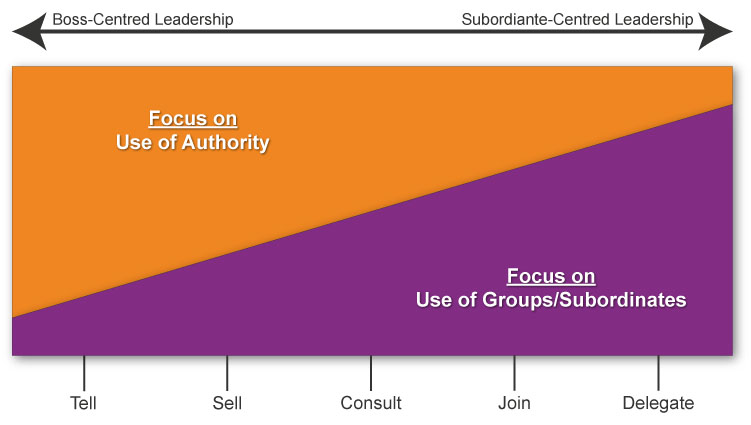It is crucial to your organisations productivity that employee involvement is present as it promotes commitment and ownership. It also creates an environment that encourages employee loyalty and motivation and will determine their productivity and success rate.
We refer to employee involvement as creating an environment that encourages employees to take an active role in the actions and decisions that have a direct impact on their working life. It’s a workplace philosophy that should be embraced by all leaders or managers in the workplace. It enables success, improvement and growth for both the organisation and its employees.
If you would like to implement and promote employee involvement through the use of a model, have a look at the one below that is based on the work of Tannenbaum and Schmidt (1958). This model promotes the idea of leaders increasing the roles of employees and decreasing the role of supervisors when it comes to decision making through different leadership approaches and methods.
Different leadership approaches
Tell
The supervisor makes the decision and informs staff. The supervisor then directs all employees on what to do and observes their actions. Tell is useful for achieving employee engagement when the team is unsure how to complete a task and needs direction, their previous leader let working standards falter, or the team is unwilling.
Sell
The supervisor makes the decision and then attempts to ‘sell’ the decision to employees so that they may see the positives in it. They will advise employees on the course of action and closely observe them, but will also be open to hearing suggestions and support the progress made. Sell is useful when the supervisor needs employees to be committed to a decision, but does not necessarily want or need their influence over the decision itself.
Consult
The supervisor recognises that employees have the capacity to contribute ideas and complete tasks, but desires to keep an amount of control. In consult, the supervisor may present the team with a range of ideas and then ask employees for their input and point of view, however makes the final decision themselves. Consult is good when a supervisor wishes to inform employees and wishes for their feedback, however wants to maintain the power they hold as leader. This technique focuses on moral and team work and encourages participation and feedback.
Join
The supervisor includes employees in the decision making and sees all employees (including themselves) as equal. The supervisor will set limits, delegate increased responsibilities, and act as a resource if needed – but will leave the task to their enthusiastic and competent team. Join has the power to make employees feel valued that their input was sought, develop employee’s skills and feel that they were treated fairly and as equals by their supervisor.
You may find that different methods are more appropriate than others for a particular situation, so make sure that you carefully identify which approach most suits the task you face. By choosing the right approach, you will help make employees feel valued and therefore increase employee involvement.






